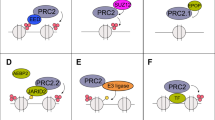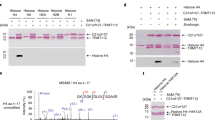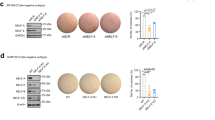Abstract
Multiple endocrine neoplasia type 1 (MEN1) is a hereditary tumor syndrome characterized by tumors of the parathyroid glands, the pancreatic islets, the pituitary gland, the adrenal glands, as well as by neuroendocrine carcinoid tumors, often at a young age. Causal to the syndrome are germline mutations of the MEN1 tumor-suppressor gene. Identification of gene-mutation carriers has enabled presymptomatic diagnosis and treatment of MEN1-related lesions. The product of the MEN1 gene is the nuclear protein menin. Recent observations indicate several functions for menin in the regulation of transcription, serving either as a repressor or as an activator: menin interacts with the activator-protein-1-family transcription factor JunD, changing it from an oncoprotein into a tumor-suppressor protein, putatively by recruitment of histone deacetylase complexes; menin maintains transforming growth factor β mediated signal transduction involved in parathyroid hormone and prolactin gene expression; and menin is an integral component of histone methyltransferase complexes. In this capacity menin is a regulator of expression of the cyclin-dependent-kinase inhibitors p18INK4C and p27Kip1; furthermore, menin serves as a co-activator of estrogen receptor mediated transcription, by recruiting methyltransferase activity to lysine 4 of histone 3 at the estrogen responsive TFF1(pS2) gene promoter. We propose that menin links transcription-factor function to histone-modification pathways and that this is crucial for MEN1 tumorigenesis. Understanding the molecular pathology of MEN1 tumorigenesis will lead to new therapeutic strategies.
Key Points
-
Multiple endocrine neoplasia type 1 is caused by germline mutations of the gene that encodes a protein termed menin
-
Menin is a nuclear protein involved in the regulation of gene expression at the level of transcription
-
Menin is a link between chromatin-modifying protein complexes and transcription regulation
-
Understanding the mechanism of action for menin will eventually provide targets for future therapeutic strategies
This is a preview of subscription content, access via your institution
Access options
Subscribe to this journal
Receive 12 print issues and online access
$209.00 per year
only $17.42 per issue
Buy this article
- Purchase on Springer Link
- Instant access to full article PDF
Prices may be subject to local taxes which are calculated during checkout

Similar content being viewed by others
References
Brandi ML et al. (2001) Guidelines for diagnosis and therapy of MEN type 1 and type 2. J Clin Endocrinol Metab 86: 5658–5671
Chandrasekharappa SC et al. (1997) Positional cloning of the gene for multiple endocrine neoplasia-type 1. Science 276: 404–407
Thompson NW (1998) Current concepts in the surgical management of multiple endocrine neoplasia type 1 pancreatic-duodenal disease. Results in the treatment of 40 patients with Zollinger-Ellison syndrome, hypoglycaemia or both. J Intern Med 243: 495–500
Geerdink EA et al. (2003) Do patients with multiple endocrine neoplasia syndrome type 1 benefit from periodical screening? Eur J Endocrinol 149: 577–582
Roijers JF et al. (2000) Criteria for mutation analysis in MEN 1-suspected patients: MEN 1 case-finding. Eur J Clin Invest 30: 487–492
Burgess JR et al. (1999) Osteoporosis in multiple endocrine neoplasia type 1: severity, clinical significance, relationship to primary hyperparathyroidism, and response to parathyroidectomy. Arch Surg 134: 1119–1123
Larsson C et al. (1988) Multiple endocrine neoplasia type 1 gene maps to chromosome 11 and is lost in insulinoma. Nature 332: 85–87
Heppner C et al. (1997) Somatic mutation of the MEN1 gene in parathyroid tumours. Nat Genet 16: 375–378
Zhuang Z et al. (1997) Somatic mutations of the MEN1 tumor suppressor gene in sporadic gastrinomas and insulinomas. Cancer Res 57: 4682–4686
Crabtree JS et al. (2001) A mouse model of multiple endocrine neoplasia, type 1, develops multiple endocrine tumors. Proc Natl Acad Sci USA 98: 1118–1123
Kouvaraki MA et al. (2002) Genotype-phenotype analysis in multiple endocrine neoplasia type 1. Arch Surg 137: 641–647
Wautot V et al. (2002) Germline mutation profile of MEN1 in multiple endocrine neoplasia type 1: search for correlation between phenotype and the functional domains of the MEN1 protein. Hum Mutat 20: 35–47
Pannett AA et al. (2003) Multiple endocrine neoplasia type 1 (MEN1) germline mutations in familial isolated primary hyperparathyroidism. Clin Endocrinol (Oxf) 58: 639–646
Olufemi SE et al. (1998) Common ancestral mutation in the MEN1 gene is likely responsible for the prolactinoma variant of MEN1 (MEN1Burin) in four kindreds from Newfoundland. Hum Mutat 11: 264–269
Guru SC et al. (1998) Menin, the product of the MEN1 gene, is a nuclear protein. Proc Natl Acad Sci USA 95: 1630–1634
Chandrasekharappa SC and Teh BT (2003) Functional studies of the MEN1 gene. J Intern Med 253: 606–615
Schnepp RW et al. (2004) Functional interaction between tumor suppressor menin and activator of S-phase kinase. Cancer Res 64: 6791–6796
Ohkura N et al. (2001) Menin, a gene product responsible for multiple endocrine neoplasia type 1, interacts with the putative tumor metastasis suppressor nm23. Biochem Biophys Res Commun 282: 1206–1210
Jin S et al. (2003) Menin associates with FANCD2, a protein involved in repair of DNA damage. Cancer Res 63: 4204–4210
Sukhodolets KE et al. (2003) The 32-kilodalton subunit of replication protein A interacts with menin, the product of the MEN1 tumor suppressor gene. Mol Cell Biol 23: 493–509
Lopez-Egido J et al. (2002) Menin's interaction with glial fibrillary acidic protein and vimentin suggests a role for the intermediate filament network in regulating menin activity. Exp Cell Res 278: 175–183
Obungu VH et al. (2003) Menin, a tumor suppressor, associates with nonmuscle myosin II-A heavy chain. Oncogene 22: 6347–6358
Agarwal SK et al. (1999) Menin interacts with the AP1 transcription factor JunD and represses JunD-activated transcription. Cell 96: 143–152
Heppner C et al. (2001) The tumor suppressor protein menin interacts with NF-κB proteins and inhibits NF-κB-mediated transactivation. Oncogene 20: 4917–4925
Kaji H et al. (2001) Inactivation of menin, a Smad3-interacting protein, blocks transforming growth factor type β signaling. Proc Natl Acad Sci USA 98: 3837–3842
Lemmens IH et al. (2001) Menin interacts directly with the homeobox-containing protein Pem. Biochem Biophys Res Commun 286: 426–431
Kim H et al. (2003) Menin, a tumor suppressor, represses JunD-mediated transcriptional activity by association with an mSin3A-histone deacetylase complex. Cancer Res 63: 6135–6139
Hughes CM et al. (2004) Menin associates with a trithorax family histone methyltransferase complex and with the hoxc8 locus. Mol Cell 13: 587–597
Yokoyama A et al. (2004) Leukemia proto-oncoprotein MLL forms a SET1-like histone methyltransferase complex with menin to regulate Hox gene expression. Mol Cell Biol 24: 5639–5649
Yazgan O and Pfarr CM (2001) Differential binding of the Menin tumor suppressor protein to JunD isoforms. Cancer Res 61: 916–920
Gobl AE et al. (1999) Menin represses JunD-activated transcription by a histone deacetylase-dependent mechanism. Biochim Biophys Acta 1447: 51–56
Gallo A et al. (2002) Menin uncouples Elk-1, JunD and c-Jun phosphorylation from MAP kinase activation. Oncogene 21: 6434–6445
Agarwal SK et al. (2003) Transcription factor JunD, deprived of menin, switches from growth suppressor to growth promoter. Proc Natl Acad Sci USA 100: 10770–10775
Blasco MA (2005) Telomeres and human disease: ageing, cancer and beyond. Nat Rev Genet 6: 611–622
Lin SY and Elledge SJ (2003) Multiple tumor suppressor pathways negatively regulate telomerase. Cell 113: 881–889
Sowa H et al. (2004) Menin inactivation leads to loss of transforming growth factor β inhibition of parathyroid cell proliferation and parathyroid hormone secretion. Cancer Res 64: 2222–2228
Lacerte A et al. (2004) Activin inhibits pituitary prolactin expression and cell growth through Smads, Pit-1 and menin. Mol Endocrinol 18: 1558–1569
Santos-Rosa H et al. (2002) Active genes are tri-methylated at K4 of histone H3. Nature 419: 407–411
Guenther MG et al. (2005) Global and Hox-specific roles for the MLL1 methyltransferase. Proc Natl Acad Sci USA 102: 8603–8608
Yokoyama A et al. (2005) The menin tumor suppressor protein is an essential oncogenic cofactor for MLL-associated leukemogenesis. Cell 123: 207–218
Franklin DS et al. (2000) Functional collaboration between different cyclin-dependent kinase inhibitors suppresses tumor growth with distinct tissue specificity. Mol Cell Biol 20: 6147–6158
Milne TA et al. (2005) Menin and MLL cooperatively regulate expression of cyclin-dependent kinase inhibitors. Proc Natl Acad Sci USA 102: 749–754
Karnik SK et al. (2005) Menin regulates pancreatic islet growth by promoting histone methylation and expression of genes encoding p27Kip1 and p18INK4c. Proc Natl Acad Sci USA 102: 14659–14664
Dreijerink KM et al. (2006) Menin links estrogen receptor activation to histone H3K4 trimethylation. Cancer Res 66: 4929–4935
La P et al. (2004) Direct binding of DNA by tumor suppressor menin. J Biol Chem 279: 49045–49054
Fraga MF et al. (2005) Loss of acetylation at Lys16 and trimethylation at Lys20 of histone H4 is a common hallmark of human cancer. Nat Genet 37: 391–400
Seligson DB et al. (2005) Global histone modification patterns predict risk of prostate cancer recurrence. Nature 435: 1262–1266
Yaguchi H et al. (2004) Menin missense mutants associated with multiple endocrine neoplasia type 1 are rapidly degraded via the ubiquitin-proteasome pathway. Mol Cell Biol 24: 6569–6580
Busygina V et al. (2004) Hypermutability in a Drosophila model for multiple endocrine neoplasia type 1. Hum Mol Genet 13: 2399–2408
Asgharian B et al. (2004) Meningiomas may be a component tumor of multiple endocrine neoplasia type 1. Clin Cancer Res 10: 869–880
Acknowledgements
The authors receive grant support from The Netherlands Organisation for Health Research and Development (ZonMw, AGIKO-920-03-231) and The Netherlands Organisation for Scientific Research (NWO, PIONIER-900-98-142).
Author information
Authors and Affiliations
Corresponding author
Ethics declarations
Competing interests
The authors declare no competing financial interests.
Rights and permissions
About this article
Cite this article
Dreijerink, K., Höppener, J., Timmers, H. et al. Mechanisms of Disease: multiple endocrine neoplasia type 1—relation to chromatin modifications and transcription regulation. Nat Rev Endocrinol 2, 562–570 (2006). https://doi.org/10.1038/ncpendmet0292
Received:
Accepted:
Issue Date:
DOI: https://doi.org/10.1038/ncpendmet0292
This article is cited by
-
Loss of tumor suppressor menin expression in high grade cholangiocarcinomas
BMC Research Notes (2023)
-
Expression of p27Kip1 and p18Ink4c in human multiple endocrine neoplasia type 1-related pancreatic neuroendocrine tumors
Journal of Endocrinological Investigation (2018)
-
Pathophysiology of Gastric NETs: Role of Gastrin and Menin
Current Gastroenterology Reports (2017)
-
mRNA expression analysis of cell cycle genes in islets of pregnant mice
Diabetologia (2010)
-
Familial pituitary tumor syndromes
Nature Reviews Endocrinology (2009)



